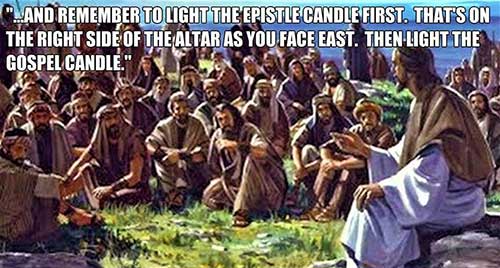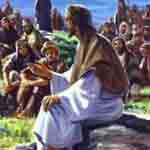
The questions in this post are not rhetorical.
And, yes, for those who think that liturgy and the study of liturgy is akin to stamp collecting or cigar-band collecting, this post can be another piece of evidence about liturgy’s esoteric irrelevance. It doesn’t hurt to have the occasional lighter (see what I did there!) post amongst the others!
Now to the blog post:
Regular readers here will know that I am at the end of the spectrum that sees a lot of worship and religious activities and rules originating in what, at the time, was a comprehensible action and then later it was given a “spiritual” or allegorical interpretation and often continued beyond the sensible life of the action because of the interpretation.
The analysis of this process is described well by the following story:
When the guru sat down to worship each evening, the ashram cat would get in the way and distract the worshipers. So he ordered that the cat be tied during evening worship.
After the guru died the cat continued to be tied during evening worship. And when the cat died, another cat was brought to the ashram so that it could be duly tied during evening worship.
Centuries later learned treatises were written by the guru’s disciples on the religious and liturgical significance of tying up a cat while worship is performed.
From Anthony De Mello, The Song of the Bird
There was a recent discussion online joking about the lighting-of-candles-in-church tradition: two candles are lit from South to North, and extinguished from North to South. From a sensible approach, this makes little sense: rather than having a system where both candles burn the same amount of time, one candle is always left to burn longer than the other.
The allegorisation is around the north side being the “Gospel” side, and then declaring a mnemonic: “The Gospel candle never burns alone”
(more here and here). But, the mnemonic is not the origin of the practice.
What is the practical origin of this widespread practice?
The best I can come up with is a completely imagined scenario: most vestries (sacristies) were on the south of the church building; the server came in, hence, from the South, lit the first candle, moved across and lit the second candle (on the North) and stayed there for most of the service; at the end, the server doused the candle on the North then the one on the South and continued back into the vestry (sacristy).
Is there evidence for such a hypothesis? Or is there evidence that the above paragraph is false? Is there an alternative origin hypothesis?
In images, yes – I can find some pictures of the server primarily on the north side with two candles. More abundant, are images with six candles and the server on the south side or with two servers.
Your responses hoped for in the comments…
If you appreciated this post, do remember to like the liturgy facebook page, use the RSS feed, and sign up for a not-very-often email, …




When I attended a service Tuesday just gone.
I was asked to light the candles.
I enquired which one to light first, left or right?
Was told to light the Christ candle first,it sat on the right of the alter, to the south of the vestry.
If the gospel candle should never burn alone then two poeple should light and put out at the same time. If the right candle is Christ, is the left Jesus or the father, God?
Where are people saying that one candle is Christ and so on, Ruth? Blessings.
Sorry, The Christ candle sat on the left of the alter, my right facing.
This is also an imagined scenario that begins with the other element of the parody -the epistle/gospel side idea. I believe it may have come from particular practice at Low Mass in France -server is on south side during Mass (oriented priest’s right hand), and reads Epistle. Why server should light South candle first, I know not. But if credence is on south side, then snuffer (with integral taper) may be too, so server will naturally reach candle first. But this falls down if server always bows centrally before and after lighting and extinguishing. I lack the books to probe any further, and am often sympathetic to the ashram’s cat theory, so sit light to many niceties. Good luck with further investigations!
P.S. Are NZ vestries often built on the north side?
Thanks, Paul. Yes – NZ vestries are often built on the north side. But this might now become someone’s doctoral thesis – with many buildings here designed in the Northern Hemisphere (or replicating them). Further: many churches in Christchurch (an Anglican settlement) were lost in the quakes. Further: many NZ church buildings would abandon orientation (see other posts on this site about orientation) – even when (say in Christchurch) our streets took church orientation into account. Blessings.
There is an answer of the Roman Congregation of Rites, 19th century, indicating that the right order is first the candles to the right of the cross – which is at the centre of the altar – and then those at the left. And inverse order to put them off. Sorry, I couldn’t find the reference. Just quoting by heart.
Also, if I’m not wrong – maybe memory is not what it used to be – the Hanukkah candles are lit in the same way: right first, then left. Maybe that’s the origin of the custom.
I don’t think we have to read political undertones in that 😉
Thanks so much, Diegwu. If anyone has links to these points, please let us know. Blessings.
My question, aside from lighting candles, is about acknowledging the altar. I was under the impression that it isn’t the altar being acknowledged with a nod, bow or curtsy, but the reserved sacrament. If the reserved sacrament isn’t present, then there is no reason to acknowledge anything, but I see many folks acknowledge a bar altar. When asked why they have no reason other than they thought that was what they were supposed to do.
I never bow if there is no reserve sacrament present and are thought by some to be in peril of hellfire.
David, I am used to people genuflecting to acknowledge the Reserved Sacrament and bowing to acknowledge the altar. Blessings.
Speaking from having served in older rites following vetus ordo Roman-inspired ceremonial, my impression was that the pattern of lighting the candles connected with the position of the missal and therefore emanates from practical considerations. At the beginning of the service the missal is on the right hand side of the altar (= Epistle side), hence lighting the candles on that side first. Just before the gospel reading the missal is moved to the left side of the altar (= Gospel side). And after communion the missal is moved back again to the right hand side, hence extinguishing the candles on that side last.
Of course the whole notion of having six candles as normal is a pretty late development. Percy Dearmer wrote pretty disparagingly of contemporary Catholic practices in this direction, and favoured the multiplication of lights as a way of marking progressive solemnity. It always leaves me bemused that in many Anglican parishes that have adopted various aspects of liturgical renewal — reordering the sanctuary for a more accessible altar, for example — have also adopted practices that would once have been considered extreme. Don’t you consider it a bit odd to have an unused altar bedecked with a big six, plus another two if it is standing free of the reredos? Yet the altar actually in use will generally only have two candles of pretty modest scale — reflecting the continuation of a more practical and restrained usage.
That’s all very helpful, Kieran. Thanks. I think we think similarly about the way that liturgical renewal often changes some things, but consequential changes don’t necessarily follow. Blessings.
Here’s another candle question! We have two services each Sunday. The first has the Eucharist each week but the second (‘contemporary’) service only celebrates the Eucharist fortnightly. I asked two respectable folk whether to light the altar candles for the non-Communion service and got two conflicting answers. One said the candles represent the light of the world, so light ’em. The other said the candles represent Christ’s presence in the elements, so no. I am consequently confused. (We are in an interregnum so it’s harder to get answers to anything just now.)
Thanks, Corinna. The best I can come up with is that you suggest your two respectable folk read this post. Both are obviously allegorising the candles. Who would/should make decisions about such allegories? Candles, originally, were there to provide light; they didn’t “represent” anything or anyone. If they represent Christ’s presence in the elements – at which point in the Eucharist do you light them? If they represent the light of the world, why are they not lit 24/7? Do these people not light candles in a wedding? A funeral? If a service is any formal service in a church building, candles are normally lit. Blessings.
I love this answer! My main concern was that if we didn’t light candles for the second service, the implication was that it was somehow inferior to the one celebrating the Eucharist. Now I’m going to go right ahead and light them. If questioned, I will say I have consulted an authority 😉
I’m now having discussions about why starched white embroidered linen is compulsory. I’m thinking a flax mat on the altar would be more bicultural, and is where linen comes from. BUT doesn’t need ironing…
Thanks, Corinna.
To my knowledge, “starched white embroidered linen” is not “compulsory”. The agreement in our Church is:
Blessings.